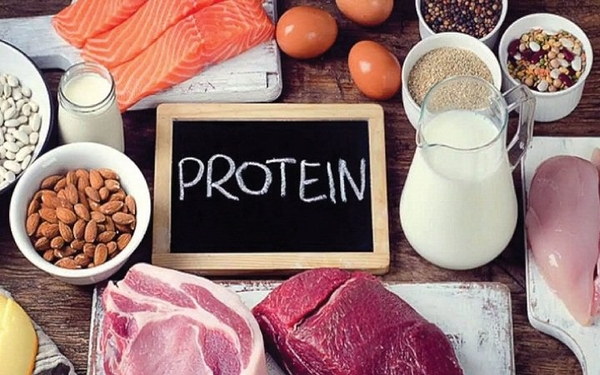 English
EnglishNutrition in the prevention of muscle loss in the elderly
As we age, physical decline is often seen as an inevitable consequence of aging. However, from a nutritional science perspective, frailty, slowness of gait, and reduced mobility in older adults are not simply “signs of aging.” They are clinical manifestations of a medical syndrome called sarcopenia, a disorder characterized by the gradual loss of skeletal muscle mass and function.

Nutrition plays an important role in preventing muscle loss in older adults
Sarcopenia not only increases the risk of falls and injuries, but also directly affects the speed of recovery from illness, the ability to metabolize, and most importantly, the independence in daily activities. However, this condition is completely preventable with an optimized diet, with protein playing a central role, along with stimulating muscles through appropriate exercise. This is the most effective way to preserve and restore physical health for the elderly.
What is Sarcopenia? Understanding Muscle Loss in the Elderly
To be able to intervene effectively, the first thing is to clearly understand the nature of this syndrome, including from the scientific definition to early signs of recognition in daily life.
Scientific Definition of Sarcopenia

Muscle loss is a decrease in muscle size, muscle mass, and muscle function
Sarcopenia is not simply a decrease in muscle size, but is defined as a musculoskeletal disease characterized by a loss of both muscle mass and muscle function, including muscle strength and performance. It is a natural process of aging but will be accelerated without proper intervention. The World Health Organization (WHO) has officially recognized Sarcopenia as a separate disease and emphasized the importance of early diagnosis and treatment.
An important question arises: why do many older adults still lose muscle despite trying to eat a nutritious diet? The answer lies in a phenomenon called “anabolic resistance”. Over time, muscle cells in older adults become less sensitive to growth signals, including signals from dietary protein and from exercise. This means that with the same amount of protein intake, older adults cannot synthesize new muscle as efficiently as younger adults. Therefore, it is not enough to just “eat sufficiently”; you need to “eat correctly”, requiring a specially designed nutritional plan to overcome this resistance barrier.
Early signs of sarcopenia that are not ignorable
Sarcopenia often progresses silently. Therefore, early recognition of the following signs can help with timely intervention:
- Slow walking, feeling of loss of balance: Decreased walking speed is one of the earliest and most important signs of muscle dysfunction.
- Difficulty performing daily activities: It may be more difficult to get up from a chair without holding onto a handrail, climb stairs, or carry even light objects.
- Feeling noticeably weak and tired quickly: Weakened grip strength (e.g. difficulty opening bottle caps) and feeling tired earlier when performing physical activities.
- Unintentional weight loss, especially in the arms and calves: Atrophy of muscle mass in the arms and legs is a visual sign of muscle loss.
Why is muscle loss (sarcopenia) dangerous for the elderly?
Sarcopenia is not simply a change in physique or strength, but also entails a series of serious consequences, deeply impacting the metabolic health, resilience and quality of life of older adults.
Increased risk of falls and serious injuries

Muscle loss increases the risk of falls in older adults
Muscles serve as the body’s dynamic support and stabilization system. When sarcopenia occurs, especially the weakening of the core muscles in the legs and trunk, the body’s ability to maintain balance and reflexes are severely impaired. The natural aging process causes atrophy and loss of quantity and function, especially in type II muscle fibers – the group of muscle fibers responsible for the powerful and immediate responses to postural correction when balance is lost.
Sarcopenia aggravates this condition, a small slip or fall can leave the elderly unable to support themselves. This significantly increases the risk of falls. In the elderly, a minor fall can lead to serious injuries such as wrist fractures and especially femoral neck fractures, a serious medical event. Femoral neck fractures not only require complex surgery but also lead to a series of complications due to prolonged immobilization such as pneumonia, pressure ulcers, venous thrombosis and can eventually lead to permanent disability and loss of the ability to live independently.
Declining resilience and loss of self-care ability
Skeletal muscle is not only a motor organ, but also the body’s largest and most important “protein reservoir”. When the body is faced with metabolic stress conditions such as infection, surgery or trauma, the demand for amino acids to synthesize immune proteins (antibodies, cytokines) and repair damaged tissue will skyrocket.
In a healthy person, the body can temporarily break down some of the protein from the muscles to meet that urgent need. However, in people with Sarcopenia, this “reserve” is already at a very low level. When stress occurs, the mobilization of protein from the muscles quickly pushes them into a state of severe exhaustion, slowing the wound healing process, increasing the risk of hospital infections and prolonging the time in the hospital. In the long term, the decline in physical condition after each illness accumulates, gradually losing the ability to perform daily activities, forcing them to depend on caregivers and seriously affecting the quality of life.
Metabolic disorders and chronic disease risk

Muscle loss increases the risk of metabolic disorders in older adults
Skeletal muscle is the largest metabolic organ in the body and plays a central role in blood sugar regulation. After a meal, approximately 80% of blood glucose is taken up by skeletal muscle and stored under the control of insulin, allowing to regulate blood sugar levels and provide energy for body functions. When muscle mass is reduced due to Sarcopenia, this glucose “storage” is significantly reduced.
At that time, the amount of sugar after eating stays in the blood longer with a higher concentration, forcing the pancreas to increase insulin production to try to handle it. This state of prolonged high insulin concentration will lead to the phenomenon of cells becoming “resistant” to the insulin signal, called insulin resistance and is also the cause of high blood sugar levels. This is the premise of type 2 diabetes. Many studies have shown a close link between Sarcopenia and an increased risk of metabolic disorders, not only diabetes but also dyslipidemia and non-alcoholic fatty liver disease.
Nutrition – the core foundation in the “fight” against muscle loss
Sarcopenia is a condition that can be effectively treated. Nutrition is the core foundation, providing the “raw materials” to build and protect muscle mass.
Protein: The “bricks” that build and regenerate muscles
Proteins in the body act as building blocks, building cell skeletons and providing scaffolding to maintain cell shape. Therefore, protein plays an irreplaceable role in maintaining muscle health. The body is constantly in a state of synthesizing and breaking down muscle proteins. To increase muscle mass, the synthesis process must be greater than the breakdown process. As mentioned, older people experience a state of “anabolic resistance”, meaning that their muscle mass synthesis process is not stimulated as strongly as that of younger people. Therefore, they need a higher amount and quality of protein to overcome this barrier.

Protein – Important nutrition to prevent muscle loss in the elderly
The International Society on Nutrition and Aging (PROT-AGE Study Group) recommends that healthy older adults consume 1.0–1.2 grams of protein per kilogram of body weight per day, and this can increase to 1.2–1.5 g/kg/day for those with chronic disease or malnutrition. High-quality protein sources include both animal (eggs, chicken, fish, milk) and plant sources (beans, tofu).
To optimize protein supplementation, the elderly need to note the following two important points:
- Distribute protein evenly into main meals of the day (breakfast, lunch, dinner), each meal about 25-30g of protein instead of eating all at one meal. This method helps stimulate muscle synthesis more regularly and effectively.
- Supplement with micronutrients that support protein absorption and metabolism such as B vitamins (especially B6), zinc and magnesium. At the same time, natural protein-digesting enzymes found in foods such as papain (from papaya) and bromelain (from pineapple) can also support this process.
Micronutrients support prevention of muscle loss
Besides protein, some other micronutrients also play an important role in protecting and enhancing body function:
- Vitamin D: In addition to being good for bones, vitamin D also plays a direct role in muscle function. Muscle cells have receptors specifically for vitamin D. Adequate vitamin D intake has been shown to improve muscle strength and reduce the risk of falls.
- Omega-3 fatty acids: Derived from fatty fish, Omega-3s have powerful anti-inflammatory properties, allowing to combat chronic inflammation – one of the contributing factors to muscle loss in older adults.

Omega 3 – An important micronutrient that fights inflammation and prevents muscle loss in the elderly
- Creatine: A natural compound that provides quick energy for high-intensity muscle contractions. Many studies have shown that creatine supplementation, especially when combined with resistance training, effectively increases muscle mass and strength in older adults.
However, older adults often face many problems in maintaining a proper diet such as loss of appetite, poor food intake, indigestion or dental problems. In this context, specially designed nutritional solutions with easily absorbed formulas become an effective intervention strategy to overcome these challenges.
Researched and developed by Nutricare and the Nutricare Medical Nutrition Institute – USA (NMNI-USA), Nutricare Bone is an effective nutritional solution that enables solution for the problem of preventing muscle loss by providing a high-quality protein source. The formula supplements 50 nutrients with Whey protein from the US and easily absorbed vegetable protein to effectively provide essential amino acids to stimulate the synthesis and regeneration of muscle mass. This is especially important to help the elderly overcome “anabolic resistance” and maintain muscle strength.
In addition to strengthening muscle mass, Nutricare Bone also supports the second pillar of the musculoskeletal system, the bones, with the combination of three key micronutrients: vitamin D3 vitamin K2 with an exceptionally high calcium content of 1800mg. This combination ensures that calcium is not only optimally absorbed from the intestine into the blood (thanks to Vitamin D3), but also transported and accurately attached to the skeleton (thanks to Vitamin K2), allowing to effectively increase bone density.
With this approach, Nutricare Bone is a nutritional solution that supports improved muscle and bone health, allowing older adults to maintain flexibility and lead an active life.
Exercise: The “golden key” to activate the muscle building process
Nutrition provides the “raw materials”, but exercise is the “signal” that tells the body to use those materials to build muscle. Nutrition and exercise are an inseparable duo in the “fight” against Sarcopenia in the elderly.

Exercise improves muscle mass in older adults
Resistance training is considered the number one and most effective choice. These are exercises that force the muscles to work against a resistance, thereby creating micro-damage in the muscle fibers and stimulating the repair process, making the muscles bigger and stronger. Simple and safe examples at home include:
- Stand up – sit down on a chair (no armrests).
- Lift small water bottles or use resistance bands.
- Heel raises to strengthen leg muscles.
- In combination, exercises like walking increase overall strength, while balance exercises (like standing on one leg) reduce the risk of falls.
Caution: Older adults should always consult a doctor or physical therapist before starting any new exercise program and should have supervision, especially in the early stages.
Conclusion
Sarcopenia in older adults is a serious health challenge that can be improved through proper nutrition and exercise. Science has shown that proactive and scientific intervention can significantly slow down and even reverse this muscle loss process. The foundation of an effective intervention strategy lies in the combination of two factors: a diet that optimizes high-quality protein intake and a personalized exercise program. Applying these factors not only allows older adults to maintain strength and muscle mass, but is also the key to protecting health, improving quality of life and enjoying the golden years to the fullest and most active.
References:
|
